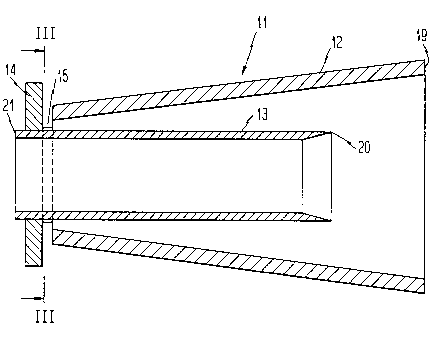Une partie des informations de ce site Web a été fournie par des sources externes. Le gouvernement du Canada n'assume aucune responsabilité concernant la précision, l'actualité ou la fiabilité des informations fournies par les sources externes. Les utilisateurs qui désirent employer cette information devraient consulter directement la source des informations. Le contenu fourni par les sources externes n'est pas assujetti aux exigences sur les langues officielles, la protection des renseignements personnels et l'accessibilité.
L'apparition de différences dans le texte et l'image des Revendications et de l'Abrégé dépend du moment auquel le document est publié. Les textes des Revendications et de l'Abrégé sont affichés :
| (12) Brevet: | (11) CA 2058865 |
|---|---|
| (54) Titre français: | PROCEDE ET JET D'EXPULSION DE L'AIR SECONDAIRE |
| (54) Titre anglais: | PROCESS AND A JET FOR DELIVERING SECONDARY AIR |
| Statut: | Périmé et au-delà du délai pour l’annulation |
| (51) Classification internationale des brevets (CIB): |
|
|---|---|
| (72) Inventeurs : |
|
| (73) Titulaires : |
|
| (71) Demandeurs : |
|
| (74) Agent: | SMART & BIGGAR LP |
| (74) Co-agent: | |
| (45) Délivré: | 1995-09-26 |
| (22) Date de dépôt: | 1992-01-07 |
| (41) Mise à la disponibilité du public: | 1992-07-25 |
| Requête d'examen: | 1992-05-25 |
| Licence disponible: | S.O. |
| Cédé au domaine public: | S.O. |
| (25) Langue des documents déposés: | Anglais |
| Traité de coopération en matière de brevets (PCT): | Non |
|---|
| (30) Données de priorité de la demande: | ||||||
|---|---|---|---|---|---|---|
|
The secondary air jets (11) that are arranged within the
combustion space (5) consist of an outer casing (12), an inner
casing (13), and a flange (14) that connects the two casings to
each other, the flange (14) crossing the inner casing (13) and
being rigidly connected with this, whereas the outer casing (12)
is so connected to the flange that is of greater diameter than
the outer casing (12) that slot-type jets (15) are left between
the face side of the outer casing (12) and the flange (14), these
jets making it possible to expel air parallel to the defining
wall and essentially perpendicular to the axis of the jets.
Note : Les revendications sont présentées dans la langue officielle dans laquelle elles ont été soumises.
Note : Les descriptions sont présentées dans la langue officielle dans laquelle elles ont été soumises.

2024-08-01 : Dans le cadre de la transition vers les Brevets de nouvelle génération (BNG), la base de données sur les brevets canadiens (BDBC) contient désormais un Historique d'événement plus détaillé, qui reproduit le Journal des événements de notre nouvelle solution interne.
Veuillez noter que les événements débutant par « Inactive : » se réfèrent à des événements qui ne sont plus utilisés dans notre nouvelle solution interne.
Pour une meilleure compréhension de l'état de la demande ou brevet qui figure sur cette page, la rubrique Mise en garde , et les descriptions de Brevet , Historique d'événement , Taxes périodiques et Historique des paiements devraient être consultées.
| Description | Date |
|---|---|
| Inactive : CIB de MCD | 2006-03-11 |
| Le délai pour l'annulation est expiré | 2006-01-09 |
| Lettre envoyée | 2005-01-07 |
| Inactive : Grandeur de l'entité changée | 2001-11-27 |
| Accordé par délivrance | 1995-09-26 |
| Demande publiée (accessible au public) | 1992-07-25 |
| Toutes les exigences pour l'examen - jugée conforme | 1992-05-25 |
| Exigences pour une requête d'examen - jugée conforme | 1992-05-25 |
Il n'y a pas d'historique d'abandonnement
| Type de taxes | Anniversaire | Échéance | Date payée |
|---|---|---|---|
| Annulation de la péremption réputée | 2001-01-08 | 1997-10-20 | |
| TM (brevet, 6e anniv.) - petite | 1998-01-07 | 1997-10-20 | |
| TM (brevet, 7e anniv.) - petite | 1999-01-07 | 1998-10-16 | |
| Annulation de la péremption réputée | 2001-01-08 | 1998-10-16 | |
| TM (brevet, 8e anniv.) - petite | 2000-01-07 | 1999-10-21 | |
| Annulation de la péremption réputée | 2001-01-08 | 1999-10-21 | |
| TM (brevet, 9e anniv.) - petite | 2001-01-08 | 2000-10-20 | |
| Annulation de la péremption réputée | 2001-01-08 | 2000-10-20 | |
| TM (brevet, 10e anniv.) - générale | 2002-01-07 | 2001-11-14 | |
| TM (brevet, 11e anniv.) - générale | 2003-01-07 | 2002-10-08 | |
| TM (brevet, 12e anniv.) - générale | 2004-01-07 | 2003-12-23 |
Les titulaires actuels et antérieures au dossier sont affichés en ordre alphabétique.
| Titulaires actuels au dossier |
|---|
| MARTIN GMBH FUR UMWELT-UND ENERGIETECHNIK |
| Titulaires antérieures au dossier |
|---|
| JOHANNES JOSEF EDMUND MARTIN |
| WALTER JOSEF MARTIN |